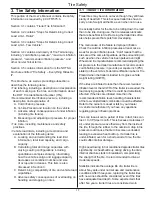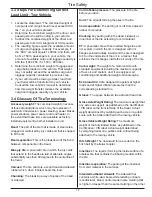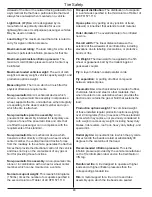
12
Some drivers place their hands at the bottom of
the steering wheel, and while the tow vehicle is in
reverse, “think” of the hands as being on the top
of the wheel. When the hands move to the right
(counter-clockwise, as you would do to turn the tow
vehicle to the left when moving forward), the rear of
the trailer moves to the right.
Conversely, rotating the steering wheel clockwise
with your hands at the bottom of the wheel will move
the rear of the trailer to the left, while backing up.
Be careful not to allow the trailer to turn too much,
because it will hit the rear of the tow vehicle. To
straighten the rig, either pull forward, or turn the
steering wheel in the opposite direction.
2.2.16 Safe Trailer Towing Guidelines
Before towing, check coupling, safety chain, brakes,
tires, wheels and lights.
Check the lug nuts or bolts for tightness.
Recheck the load tie downs to make sure the load will
not shift during towing.
Check coupler tightness after towing 50 miles.
Adjust the brake controller to engage the trailer
brakes before the tow vehicle brakes. Follow the
brake controller manufacturer’s literature.
Use your mirrors to verify that you have room to
change lanes or pull into traffi c.
Use your turn signals well in advance.
Allow plenty of stopping space for your trailer and tow
vehicle.
Use lower gears for climbing and descending grades.
Do not ride the brakes while descending grades; they
may get so hot that they stop working. Then you will
potentially have a runaway tow vehicle and trailer.
Do not apply the tow vehicle brakes to correct
extreme trailer swaying. Instead, lightly apply the
trailer brakes with the hand controller.
Make regular stops, about once each hour. Confi rm
that:
•
The coupler is secure to the hitch and is locked.
•
Electrical connectors are made.
•
There is appropriate slack in safety chains.
•
There is appropriate slack in breakaway lanyard.
•
The tires are not visibly low on pressure.
•
The cargo is secure and in good condition.
Slow down for bumps in the road.
Do not brake while in a curve unless absolutely
necessary. Instead, slow down before you enter the
curve.
Do not drive so fast that the trailer begins to sway due
to speed. Generally never drive faster than 55 m.p.h.
Allow plenty of room for passing. A rule of thumb is
that the passing distance with a trailer is 4 times the
passing distance without a trailer.
Safety
Summary of Contents for Utility Trailer
Page 14: ...14 Safety ...
Page 52: ...52 ...













































